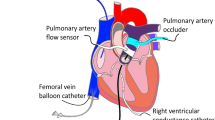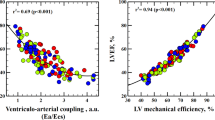Summary
Impaired excitation-contraction coupling has been suggested as the underlying mechanism of postischemic contractile dysfunction of reperfused myocardium in in-vitro studies. To test this hypothesis in situ, postextrasystolic potentiation (PESP) following an extrasystole with constant prematurity and three different postextrasystolic time intervals (compensated, regular, abbreviated) was analyzed in 12 anesthetized dogs. Changes in regional inotropic state were assessed by comparison of end-systolic wall thickness (sonomicrometry) during PESP to the respective pressure-matched values of an end-systolic pressure/wall-thickness relationship established during brief manual clamping of the aorta. Before ischemia, posterior end-systolic wall-thickness was increased by 0.19±0.35 (SD) mm during PESP with an abbreviated, by 0.36±0.42 mm with a regular, and by 0.60±0.42 mm with a compensated postextrasystolic interval. Bascline systolic wall thickening was decreased from 16.2±5.4% (before ischemia) to −3.0±3.4% at the end of 15 min left circumflex coronary occlusion, and to 2.8±7.5% at 10 min, 7.2±3.9% at 4 h, and 7.9±4.1% at 8 h reperfusion. Stepwise increases in regional inotropic state during PESP with increasing postextrasystolic intervals were not different in normal and reperfused myocardium. Thus, excitation-contraction coupling appears not to be impaired during inotropic stimulation of reperfused myocardium in situ.
Similar content being viewed by others
References
Aversano T, Maughan WL, Hunter WC, Kass D, Becker LC (1986) End-systolic measures of regional ventricular performance. circulation 73:938–950
Aversano T, Maughan WL, Sunagawa K (1988) Effect of afterload resistance on end-systolic pressure-thickness relationship. Am J Physiol 254:H658-H663
Becker LC, Levine JH, DiPaula AF, Guarnieri T, Aversano T (1986) Reversal of dysfunction in postischemic stunned myocardium by epinephrine and postextrasystolic potentiation. J Am Coll Cardiol 7:580–589
Bolli R, Zhu W-X, Myers ML, Hartley CJ, Roberts R (1985) Beta-adrenergic stimulation reverses postischemic myocardial dysfunction without producing subsequent deterioration. Am J Cardiol 56:964–968
Braunwald E, Kloner RA (1982) The stunned myocardium: prolonged, postischemic ventricular dysfunction. Circulation 66:1146–1149
Ciuffo AA, Ouyang P, Becker LC, Levin L, Weisfeldt ML (1985) Reduction of sympathetic inotropic response after ischemia in dogs. Contributor to stunned myocardium. J Clin Invest 75:1504–1509
Cohn LH, Collins Jr JJ, Cohn PF (1976) Use of the augmented ejection fraction to select patients with left ventricular dysfunction for coronary revascularization. J Thorac Cardiovasc Surg 72:835–840
Cohn PF (1980) Editorial: evaluation of inotropic contractile reserve in ischemic heart disease using postextrasystolic potentiation. Circulation 61:1071–1075
Cohn PF, Gorlin R, Herman MV, Sonnenblick EH, Horn HR, Cohn LH, Collins Jr JJ (1975) Relation between contractile reserve and prognosis in patients with coronary artery disease and a depressed ejection fraction. Circulation 51:414–420
Cooper MW, Lutherer LO, Stanton MW, Lust Jr RM (1986) Postextrasystolic potentiation: regional wall motion before and after revascularization. Am Heart J 111:334–339
Crozatier B (1982) Relations between myocardial blood flow and postextrasystolic potentiation in epicardial and endocardial left ventricular regions carly after coronary occlusion in dogs. Circulation 66:938–944
DeBoer LWV, Ingwall JS, Kloner RA, Braunwald E (1980) Prolonged derangements of canine myocardial metabolism after a brief coronary artery occlusion not associated with anatomic evidence of necrosis. Proc Natl Acad Sci USA 77:5471–5475
Deussen A, Heusch G (1984) Einfluß einer akuten Myokardischämie auf die hämodynamischen Parameter des Restmyokards. Herzmedizin 7:32–35
Diamond GA, Forrester JS, de Luz PL, Wyatt HL, Swan HJC (1978) Postextrasystolic potentiation of ischemic myocardium by atrial stimulation. Am Heart J 95:204–209
Dyke SH, Cohn PF, Gorlin R, Sonnenblick EH (1974) Detection of residual myocardial function in coronary artery disease using postextrasystolic potentiation. Circulation 50:694–699
Ellis SG, Wynne J, Braunwald E, Henschke CI, Sandor T, Kloner RA (1984) Response of reperfusion-salvaged, stunned myocardium to inotropic stimulation. Am Heart J 107:13–19
Force T, Kemper AJ, Cohen C, Parisi AF (1985) Early loss of postextrasystolic potentiation in acutely ischemic myocardium: evaluation by contrast two-dimensional echocardiography. Circulation 71:602–609
Gallagher KP, Gerren RA, Stirling MC, Choy M, Dysko RC, McManimon SP, Dunham WR (1986) The distribution of functional impairment across the lateral border of acutely ischemic myocardium. Circ Res 58:570–583
Gibson DG, Fleck E, Rudolph W (1983) Effect of postextrasystolic potentiation on amplitude and timing of regional left ventricular wall motion in ischaemic heart disease. Br Heart J 49:466–476
Guth BD, Martin JF, Heusch G, Ross Jr J (1987) Regional myocardial blood flow, function and metabolism using phosphorus-31 nuclear magnetic resonance spectroscopy during ischemia and reperfusion. J Am Coll Cardiol 10:673–681
Guth BD, White FC, Gallagher KP, Bloor CM (1984) Decreased systolic wall thickening in myocardium adjacent to ischemic zones in conscious swine during brief coronary artery occlusion. Am Heart J 107:458–464
Guth BD, White FC, Widmann T, Lew W, Bloor CM (1988) Decreased regional contractility in nonischemic myocardium during acute coronary artery occlusion in conscious pigs. Am J Cardiovasc Path 1:379–387
Heusch G, Frehen D, Kröger K, Schulz R, Thämer V (1988) Integrity of sympathetic neurotransmission in stunned myocardium. J Appl Cardiol 3:259–272
Heusch G, Guth BD, Widmann T, Peterson KL, Ross Jr J (1987) Ischemic myocardial dysfunction assessed by temporal Fourier transform of regional myocardial wall thickening. Am Heart J 113:116–124
Heusch G, Schäfer S, Kröger K (1988) Recruitment of inotropic reserve in “stunned” myocardium by the cardiotonic agent AR-L 57. Basic Res Cardiol 83:602–610
Heyndrickx GR, Baig H, Nellens P, Leusen I, Fishbein MC, Vatner SF (1978) Depression of regional blood flow and wall thickening after brief coronary occlusions. Am J Physiol 234:H653-H659
Heyndrickx GR, Millard RW, McRitchie RJ, Maroko PR, Vatner SF (1975) Regional myocardial functional and electrophysiological alterations after brief coronary artery occlusion in conscious dogs. J Clin Invest 56:978–985
Hodgson JMcB, O'Neill WW, Laufer N, Bourdillon PDV, Walton Jr JA, Pitt W (1984) Assessment of potentially salvageble myocardium during acute myocardial infarction: use of postextrasystolic potentiation. Am J Cardiol 54:1237–1244
Hoffman BF, Bindler E, Suckling EE (1956) Postextrasystolic potentiation of contraction in cardiac muscle. Am J Physiol 185:95–102
Ito BR, Tate H, Kobayashi M, Schaper W (1987) Reversibly injured, postischemic canine myocardium retains normal contractile reserve. Circ Res 61:834–846
Kalff V, Chan W, Rabinovitch M, O'Neill W, Walton J, Stewart J, Thrall JH, Pitt B (1982) Radionuclide evaluation of postextrasystolic potentiation of left ventricular function induced by atrial and ventricular stimulation. Am J Cardiol 50:106–111
Kass DA, Maughan WL (1988) From “Emax” to pressure-volume relations: a broader view. Circulation 77:1203–1212
Kass DA, Yamazaki T, Burkhoff D, Maughan WL, Sagawa K (1986) Determination of left ventricular end-systolic pressure-volume relationships by the conductance (volume) catheter technique. Circulation 73:586–595
Kusuoka H, Porterfield JK, Weisman HF, Weisfeldt ML, Marban E (1987) Pathophysiology and pathogenesis of stunned myocardium: Depressed Ca-activation of contraction as a consequence of reperfusion-induced cellular calcium overload in ferret hearts. J Clin Invest 79:950–961
Lee JD, Tajimi T, Widmann T, Ross Jr J (1987) Application of end-systolic pressure-volume and pressure-wall thickness relations in conscious dogs. J Am Coll Cardiol 9:136–146
Lew WYW, Chen Z, Guth BD, Covell JW (1985) Mechanisms of augmented segment shortening in nonischemic areas during acute ischemia of the canine left ventricle. Circ Res 56:351–358
Lust Jr RM, Lutherer LO, Gardner ME, Cooper MW (1982) Postextrasystolic potentiation and contractile reserve: requirements and restrictions. Am J Physiol 243:H990-H997
Mercier JC, Lando U, Kanmatsuse K, Ninomiya K, Meerbaum S, Fishbein MC, Swan HJC, Ganz W (1982) Divergent effects of inotropic stimulation on the ischemic and severely depressed reperfused myocardium. Circulation 66:397–400
Osakada G, Hess OM, Gallagher KP, Kemper WS, Ross Jr J (1983) End-systolic dimension-wall thickness relations during myocardial ischemia in conscious dogs. A new approach for defining regional function. Am J Cardiol 51:1750–1758
Sagawa K, Maughan L, Suga H, Sunagawa K (1987) Physiologic determinants of the ventricular pressure-volume relationship. In: Cardiac contraction and the pressure-volume relationship. Sagawa K, Maughan L, Suga H, Sunagawa K (eds) Oxford University Press, New York Oxford, pp 110–170
Schipke J, Heusch G, Schulz R, Thämer V (1987) An easy and quick implantation procedure for the measurement of myocardial wall thickness using sonomicrometry. Basic Res Cardiol 82:411–414
Schipke JD, Alexander Jr J, Harasawa Y, Schulz R, Burkhoff D (1988) Interrelation between end-systolic pressure-volume and pressure-wall thickness relations. Am J Physiol 255:H679-H684
Schulz R, Hücking G, Heusch G (1989) “CORDAT”—a new data acquisition and reduction program. Eur Heart J 10:309 (abstr)
Suga H, Sagawa K (1974) Instantaneous prssure-volume relationships and their ratio in the excised, supported canine left ventricle. Circ Res 35:117–126
Swain JL, Sabina RL, McHale PA, Greenfield JC, Holmes EW (1982) Prolonged myocardial nucleotide depletion after brief ischemia in the open-chest dog. Am J Physiol 242:H818-H826
Thaulow E, Guth BD, Heusch G, Gilpin E, Schulz R, Kröger K, Ross Jr J (1989) Characteristics of regional myocardial stunning after exercise in dogs with chronic coronary stenosis. Am J Physiol 257:H113-H119
Theroux P, Franklin D, Ross Jr J, Kemper WS (1974) Regional myocardial function during acute coronary artery occlusion and its modification by pharmacological agents in the dog. Circ Res 35:896–908
Yamazoe M (1987) Response of the left ventricle in idiopathic dilated cardiomyopathy to postextrasystolic potentiation. Am Heart J 113:1449–1456
Yue DT, Burkhoff D, Franz MR, Hunter WC, Sagawa K (1985) Postextrasystolic potentiation of the isolated canine left ventricle. Relationship to mechanical restitution. Circ Res 56:340–350
Author information
Authors and Affiliations
Additional information
Supported by grant He 1320/3-2 of the German Research Foundation. This study is part of S. Schäfer's MD thesis.
Rights and permissions
About this article
Cite this article
Schäfer, S., Heusch, G. Recruitment of a time-dependent inotropic reserve by postextrasystolic potentiation in normal and reperfused myocardium. Basic Res Cardiol 85, 257–269 (1990). https://doi.org/10.1007/BF01907114
Received:
Issue Date:
DOI: https://doi.org/10.1007/BF01907114




